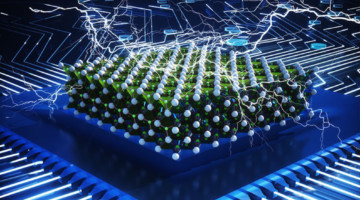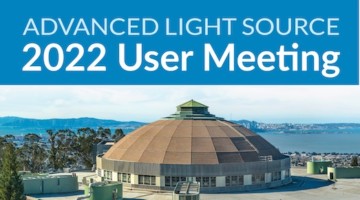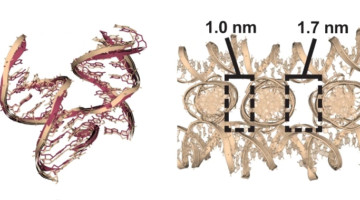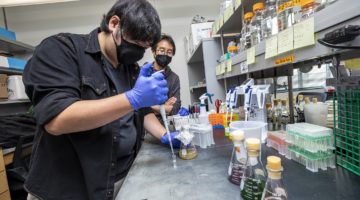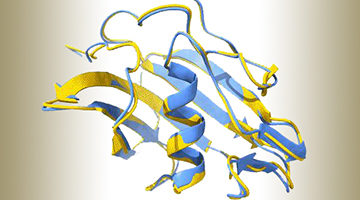Researchers found that a multilayer stack of ultrathin materials exhibits a phenomenon called negative capacitance, which reduces the voltage required for transistor operation. The material is fully compatible with today’s silicon-based technology and is capable of reducing power consumption without sacrificing transistor size or performance. Read more »![]()
![]()
2022 User Meeting Highlights
The ALS User Meeting was held August 15–17, 2022, co-chaired by UEC members Hope Michelsen, Yu He, and Rourav Basak. With Steve Kevan’s retirement and the approaching ALS-U implementation phase, the overarching theme of this year’s User Meeting was a celebration of the glorious past and anticipation of a very bright future. Read more »
ALS in the News (August 2022)
-
-
-
- Scientists grow lead-free solar material with a built-in switch
- Protein structures aren’t set in stone
- DOE announces $540 million for technologies to transform energy production and cut emissions
- A faster way to study 2D materials for next-generation quantum and electronic devices
- R&D 100 Awards honor seven Berkeley Lab innovations (IR spectral phenotyping)
- New insights into a dynamic protein targeted in cancer therapy
- Dr. Patrick Naulleau, Ph.D., named CEO of EUV Tech, Inc.
- Breaking boundaries in IR imaging to explore multiscale microbial activity in Arctic soils
-
-
An Expanded Set of DNA Building Blocks for 3D Lattices
Researchers studied 36 DNA-based molecular junctions and discovered factors that yield superior self-assembled 3D lattice structures. The work expands the set of building blocks for lattices that can scaffold molecules into regular arrays, from proteins for structure studies to nanoparticles for nano-antennas and single-particle sensors. Read more »![]()
![]()
Protein Structures Aren’t Set in Stone
A group of researchers studying the world’s most abundant protein, an enzyme involved in photosynthesis called rubisco, showed how evolution can lead to a surprising diversity of molecular assemblies that all accomplish the same task. The findings reveal the possibility that many of the proteins we thought we knew actually exist in other, unknown shapes. Read more »
Disorder Drives Long-Range Order in “Tetris Ice” Nanomagnet Arrays
Long-range ordering is typically associated with a decrease in disorder, or entropy. Yet, it can also be driven by increasing entropy in certain special cases. In a recent DOE-funded study, researchers demonstrated that certain artificial spin-ice arrays—nanomagnets lithographically patterned to form Tetris-like shapes—can produce such entropy-driven order. Read more »
Deep-Learning AI Program Accurately Predicts Key Rotavirus Protein Fold
Rotaviruses are the major causative agents of gastroenteritis worldwide. Attempts to design vaccines are complicated by the rotaviruses’ enormous genetic and immunological diversity. At the ALS, researchers validated the novel structure of a key rotavirus protein, predicted using AlphaFold2, a deep-learning artificial-intelligence program. Read more »
Versatile Sequential Casting Processing for Highly Efficient and Stable Binary Organic Photovoltaics
Ideal bulk heterojunction morphology is critical in organic solar cells (OSCs). Here, researchers show how sequential casting improves device performance in both fullerene- and nonfullerene-based systems, in which the donor and acceptor are deposited sequentially. The film spin-coating method is analogous to the traditional Chinese pancake-making process. Read more »
Ionic Conduction Mechanism and Design of Metal–Organic Framework Based Quasi-Solid-State Electrolytes
This cover image demonstrates the critical role of the solvent in the ion motion of intrinsically anionic metal–organic framework (MOF)–based quasi-solid-state electrolytes (QSSEs). Using hybrid theoretical and experimental approaches, we have identified solvent-assisted hopping as the dominant pathway for Li+ conduction in such materials, exemplified by MOF-688. Read more »
Hybrid Semiconductors Perform Under Pressure
Researchers found that compressing hybrid (organic–inorganic) semiconductors significantly boosts their conductivity. The work demonstrates a novel doping mechanism in which the material’s organic molecules serve as charge reservoirs for tuning charge-carrier concentration, with promising applications in solar cells, lasers, and LEDs. Read more »![]()
![]()
- « Previous Page
- 1
- …
- 20
- 21
- 22
- 23
- 24
- …
- 83
- Next Page »
